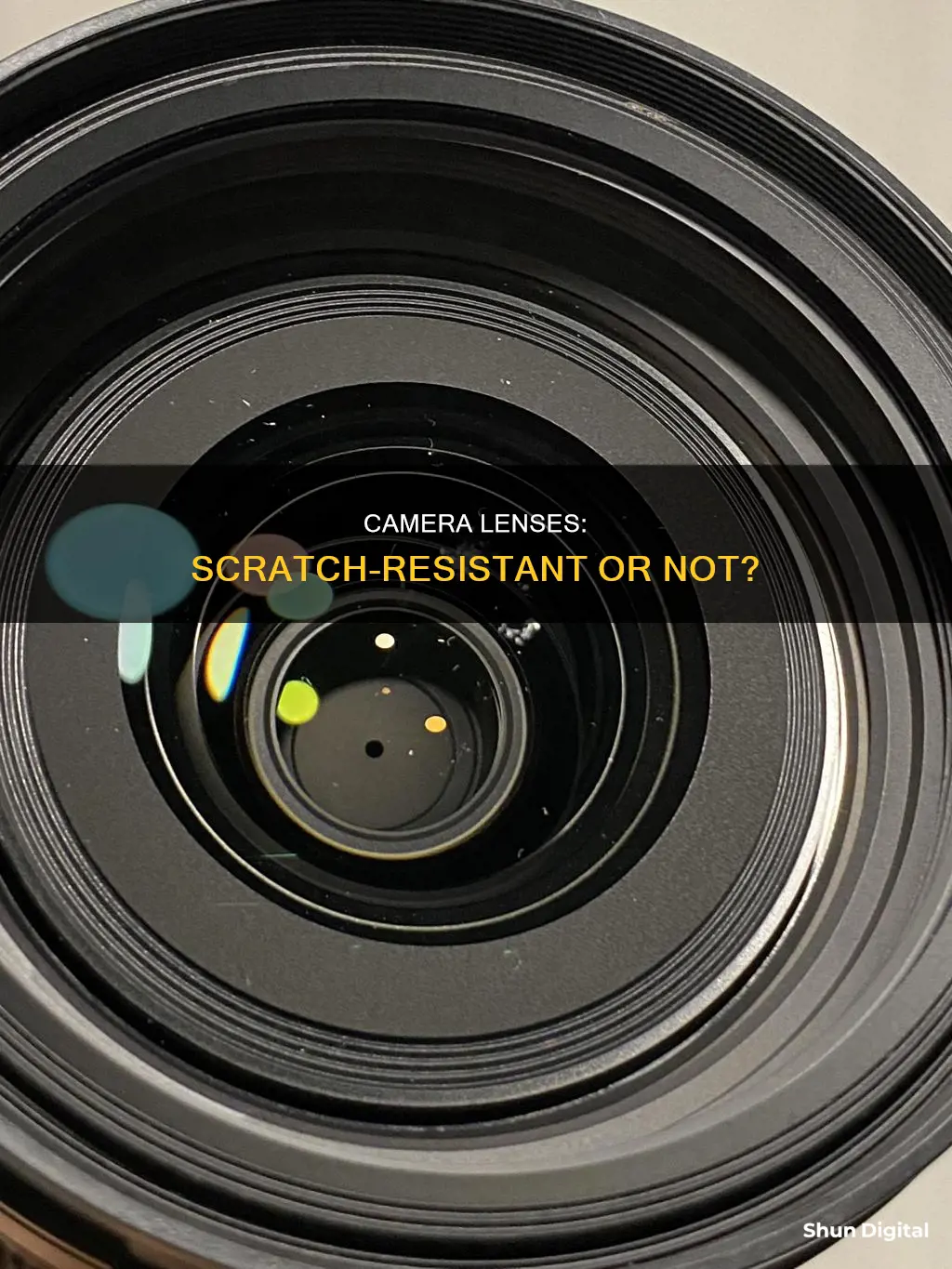
Camera lenses are the backbone of every captivating photograph, but they face a multitude of challenges in their pursuit of the perfect shot. Scratches are a common concern for photographers, and the quest for scratch-resistant lenses has become a priority. In this exploration, we will delve into the intricacies of camera lens construction, the materials used, and the reality behind scratch resistance claims. Are camera lenses inherently scratch-resistant, or is it a delicate balance of marketing and technological advancements? Let's uncover the truth.
| Characteristics | Values |
|---|---|
| Lens Construction | A camera lens typically consists of multiple optical elements, including glass or specialized materials, arranged in precise configurations to manipulate light and capture images. |
| Materials Used | High-quality optical glass, fluorite, and high-grade plastics such as polycarbonate. Glass is inherently resistant to scratches, while fluorite is softer and more susceptible to scratches, and high-grade plastics are more susceptible to scratches compared to glass. |
| Scratch-Resistant Coatings | Fluorine coating is a widely used coating that provides scratch resistance, repels water, oil, and dirt. The effectiveness of scratch-resistant coatings varies, and higher-quality coatings offer better protection. |
| Factors Influencing Scratch Resistance | The material composition, hardness of the lens surface, and environmental factors such as dust, sand, and improper cleaning practices impact the vulnerability of camera lenses to scratches. |
| Lens Care | Use lens caps, lens hoods, and quality lens filters to protect the lens. Clean lenses with a soft, lint-free microfiber cloth and lens cleaning solution. Store lenses in a protective case away from extreme temperatures, high humidity, and direct sunlight. |
What You'll Learn

Lens construction
Camera lenses are constructed from a variety of materials, including glass and plastic, and are designed to capture and transmit images with clarity. The construction of a camera lens involves the precise arrangement of multiple optical elements, each playing a crucial role in the overall performance of the lens.
A typical camera lens consists of several lens elements, which are individual lenses of different shapes and distances of separation. These elements are made from optical glass or plastic, with glass being the most common material due to its good optical properties and resistance to scratching. Each element has a specific shape, such as convex, biconvex, plano-convex, concave, biconcave, or plano-concave, which influences the way light rays are refracted or bent. By combining these elements in a specific configuration, camera lenses can reduce aberrations and produce sharp, high-quality images.
The front element of the lens is particularly crucial to the overall performance. It is usually coated to reduce abrasion, flare, and surface reflectance, as well as to adjust the color balance. This coating plays a vital role in enhancing the durability of the lens and ensuring consistent image quality. The curvature of the front element is also significant, as it affects the angle of incidence and the angle of refraction.
In addition to the lens elements, other components contribute to the construction of a camera lens. The barrel, for instance, serves as the chassis that supports the various lens elements and provides a cosmetic exterior. It is typically made from metal or plastic, with metal mounts offering greater durability and precision. The diaphragm, also known as the stop or aperture, controls the amount of light passing through the lens and is usually a multi-leaf mechanism that adjusts the size of the opening.
The design of a camera lens takes into account various factors, including the intended use, cost, weight, and available materials. The complexity of the lens depends on factors such as the size of the aperture, the range of angles it covers, and the desired level of correction for aberrations. Advancements in technology have allowed designers to utilise computer programs to adjust the shaping and spacing of lens elements, optimising their performance and evaluating production costs.
In summary, camera lens construction involves the intricate arrangement of lens elements, each made from specific materials and designed to work together to capture and transmit images effectively. The front element, coatings, barrel, and diaphragm are all critical components that contribute to the overall performance and durability of the lens.
Best Places to Sell Your Camera Lenses Online
You may want to see also

Lens materials
Camera lenses are typically made of optical glass or plastic, with each material possessing unique properties that impact the lens's optical performance and susceptibility to scratches.
Optical Glass
High-quality optical glass is renowned for its exceptional clarity and ability to transmit light effectively. Glass elements are inherently resistant to scratches, providing a robust foundation for lens durability. However, glass lenses are generally heavier and more expensive than their plastic counterparts. The choice of glass type involves a balance between optical quality and cost, as some types of glass are denser and more expensive than others.
Fluorite
Fluorite is an exotic and expensive lens material that offers superior optical qualities. However, it is generally softer than traditional glass, making fluorite-based lenses more susceptible to scratches and requiring careful handling.
High-Grade Plastics
High-grade plastics, such as polycarbonate, are commonly used for lightweight and budget-friendly lenses. Advancements in plastic technology have improved the durability of plastic lenses, but they may still be more prone to scratches compared to high-quality glass. Plastic lenses offer advantages such as ease of manufacture, low raw material cost, and the ability to mould the lens and its mount in a single operation. However, the variety of available optical plastics is limited, and plastic lenses are generally softer and have higher thermal expansion than glass.
Camera Lenses: Expensive, Fragile, and Worthy of Insurance Coverage
You may want to see also

Scratch-resistant coatings
Camera lenses are made from a variety of materials, including glass, fluorite, and high-grade plastics like polycarbonate. While glass is inherently resistant to scratches, fluorite is softer and more prone to scratching, and high-grade plastics can be more susceptible to scratches than glass. This is where scratch-resistant coatings come into play.
When it comes to choosing a lens with effective scratch resistance, it's recommended to consider the reputation of the manufacturer. Established manufacturers with a focus on quality often invest in advanced coatings, resulting in improved scratch resistance. Additionally, user reviews can provide valuable insights into the durability of specific lens coatings.
While scratch-resistant coatings enhance the protection of camera lenses, they do not guarantee invincibility. Photographers must also practice responsible handling and care to ensure the longevity of their equipment. This includes using lens caps and hoods, investing in quality lens filters, and adopting careful cleaning practices with soft, lint-free microfiber cloths and appropriate cleaning solutions.
In conclusion, scratch-resistant coatings are an essential aspect of camera lens construction, providing an extra layer of defence. However, a combination of technological advancements and meticulous care practices is necessary to effectively protect camera lenses from scratches.
Why Are Camera Lenses Round?
You may want to see also

Lens care
Camera lenses are delicate and expensive pieces of equipment, so it's important to know how to care for them properly. While some lenses have scratch-resistant coatings, they are not scratch-proof, and careful handling is required to keep them in good condition.
Lens Caps and Hoods
Always use lens caps when the lens is not in use to protect the front and rear elements from dust and scratches. Lens hoods can also provide an extra layer of protection, especially when shooting outdoors.
Quality Lens Filters
Consider using a UV or clear filter as a sacrificial element to absorb any scratches, protecting the lens underneath. Ensure you invest in a high-quality filter to avoid compromising image quality.
Cleaning
Use a soft, lint-free microfiber cloth to gently wipe away dust and smudges. If more thorough cleaning is needed, use a lens cleaning solution specifically designed for optics. Avoid using rough or abrasive materials that could scratch the lens surface.
Changing Lenses
Be cautious when changing lenses to prevent accidental drops or impacts. Hold the camera with the lens facing downward to minimise the risk of dust or debris entering the camera body.
Storage
When not in use, store your lenses in a protective case or bag, away from extreme temperatures, high humidity, and direct sunlight. Consider using a digital cabinet or a DIY "dry box" with silica gel if you live in a humid environment to protect your lenses from fungus.
Handling
Be mindful of your surroundings when using your camera, especially outdoors. Avoid environments with dust, sand, and other abrasive particles that can scratch your lens. Always have a firm grip on your equipment to prevent accidental drops.
Protect Your Camera Lens: Storage Tips for Photographers
You may want to see also

Lens hoods and caps
- Always use lens caps when your camera is not in use. Lens caps protect both the front and rear elements of your lenses from dust and scratches. They are cheap and effective, so make sure to use them!
- Lens hoods provide an additional layer of physical protection, especially when shooting outdoors. They can absorb impacts and protect your lens from accidental bumps and knocks.
- When storing your camera, keep your lenses in a protective case or bag. This will shield them from extreme temperatures, high humidity, and direct sunlight, all of which can be harmful.
- Be cautious when changing lenses to prevent accidental drops or impacts. Always hold the camera with the lens facing downward to minimise the risk of dust or debris entering the camera body.
- If you're shooting in a dusty or sandy environment, consider using a lens hood and a UV or clear filter. These filters act as sacrificial elements, absorbing potential scratches and providing an extra layer of protection. However, invest in high-quality filters to avoid compromising image quality.
- Clean your lenses regularly with a soft, lint-free microfiber cloth and, if needed, a lens cleaning solution specifically designed for optics. Avoid using rough or abrasive materials that could scratch the lens surface.
Japan's Camera Lens Market: Affordable Photography Superpower?
You may want to see also
Frequently asked questions
Camera lenses are made from a variety of materials, including glass, fluorite, and high-grade plastics, each with different levels of scratch resistance. While high-quality glass is generally scratch-resistant, alternative materials may be more susceptible to scratches. Additionally, lens coatings can provide an extra layer of protection, but they don't make the lenses scratch-proof.
The material composition of the lens is a significant factor. High-quality glass is more resistant to scratches, while materials like fluorite and high-grade plastics may require extra care. The hardness of the lens surface also matters, but harder lenses may be more brittle and prone to cracking.
Use lens caps and hoods to protect the lens when not in use and during outdoor shoots. Invest in quality lens filters as sacrificial elements to absorb potential scratches. Always clean your lenses gently with a soft, lint-free microfiber cloth and a lens cleaning solution designed for optics. Avoid using rough or abrasive materials.
Extreme outdoor conditions with dust, sand, or other abrasive particles pose the highest risk of scratches. General handling and storage can also be risky, so always use lens caps, protective cases, and lens filters to minimize the risk of scratches.







